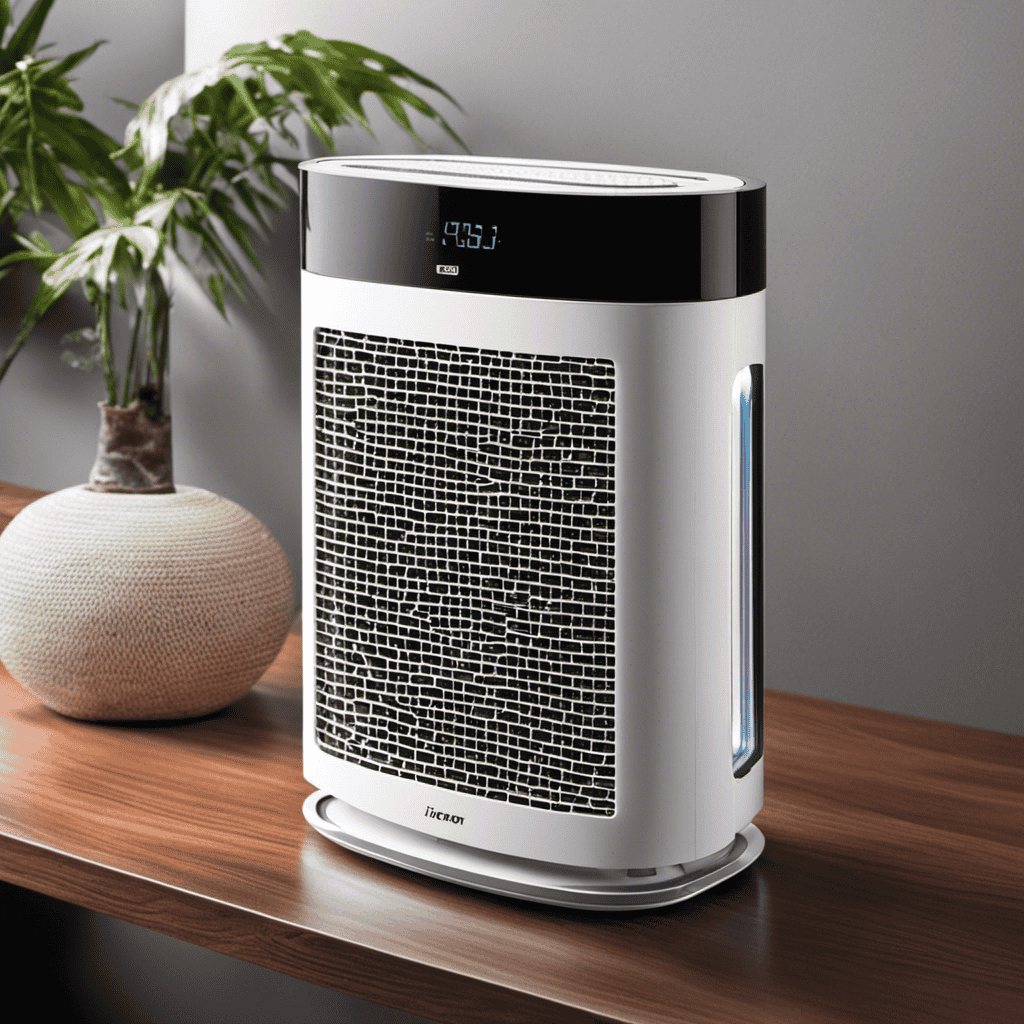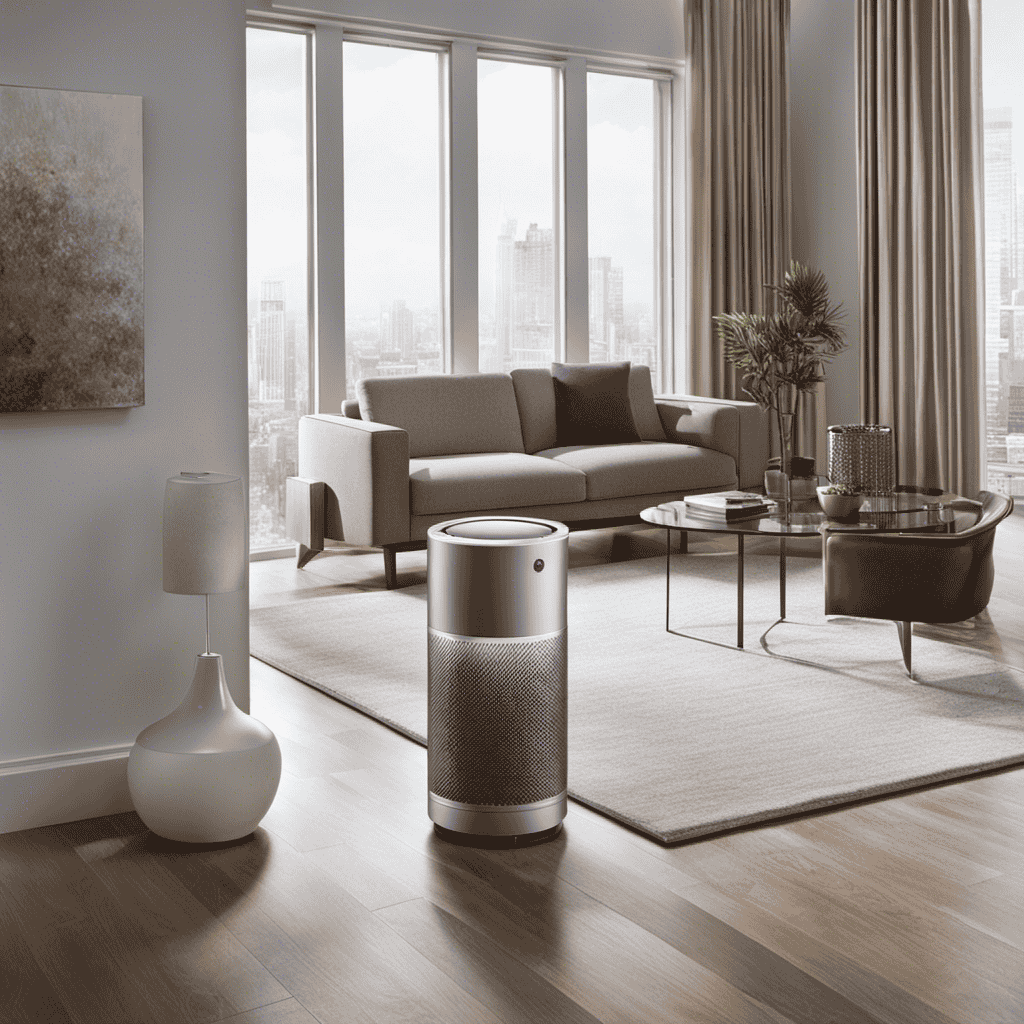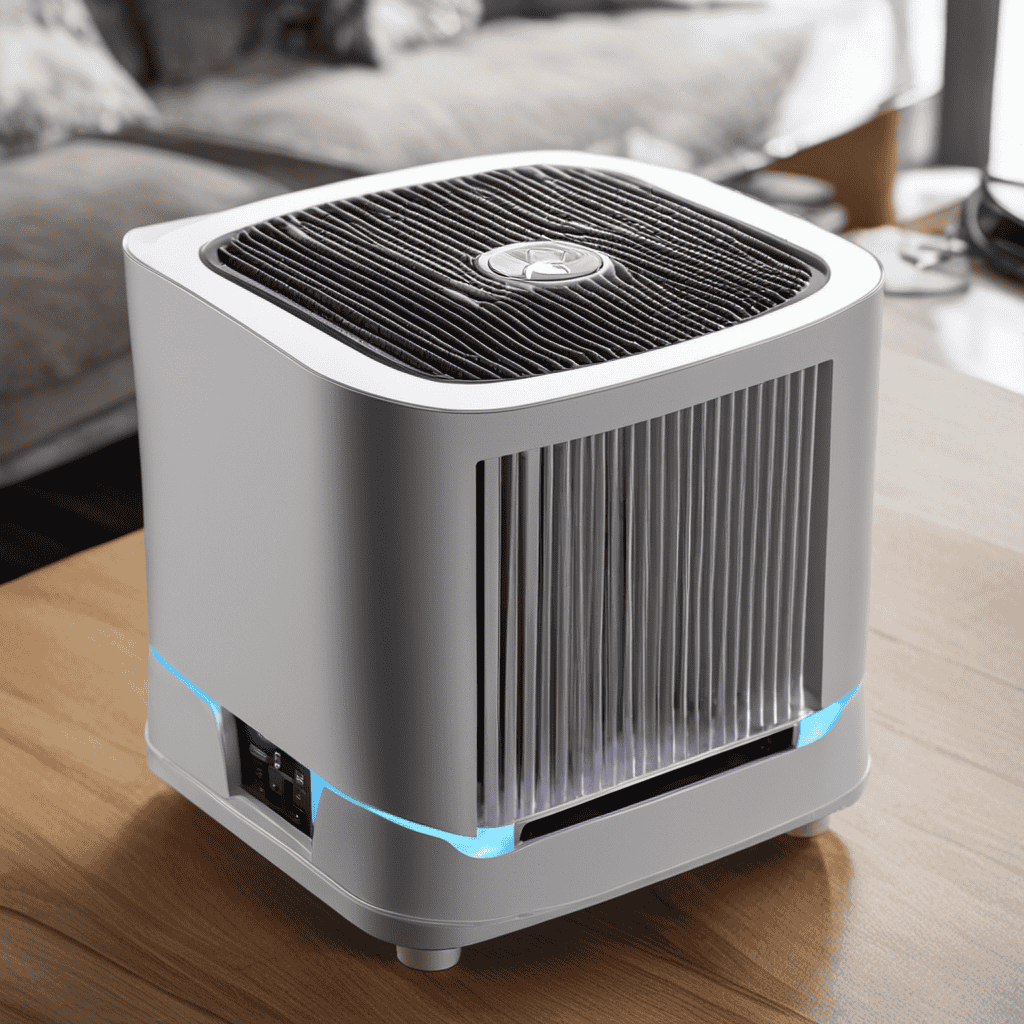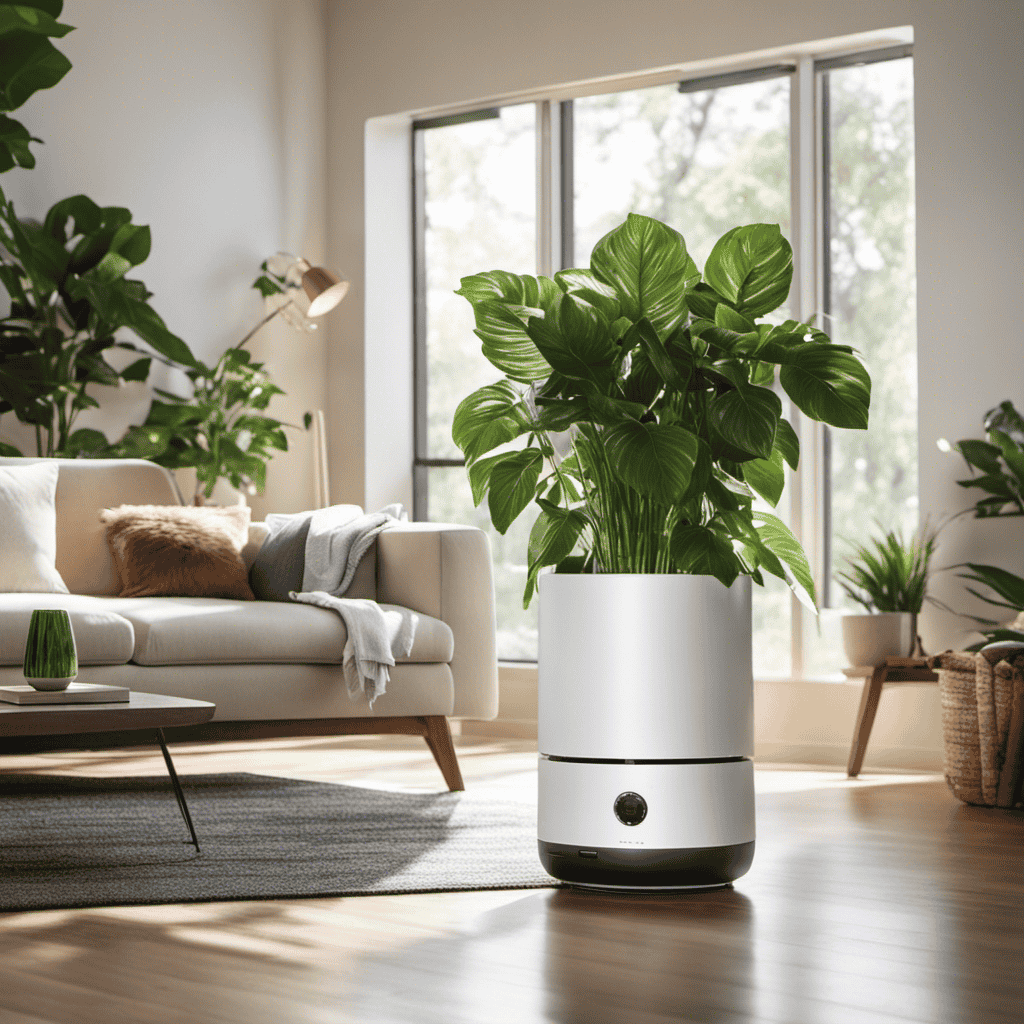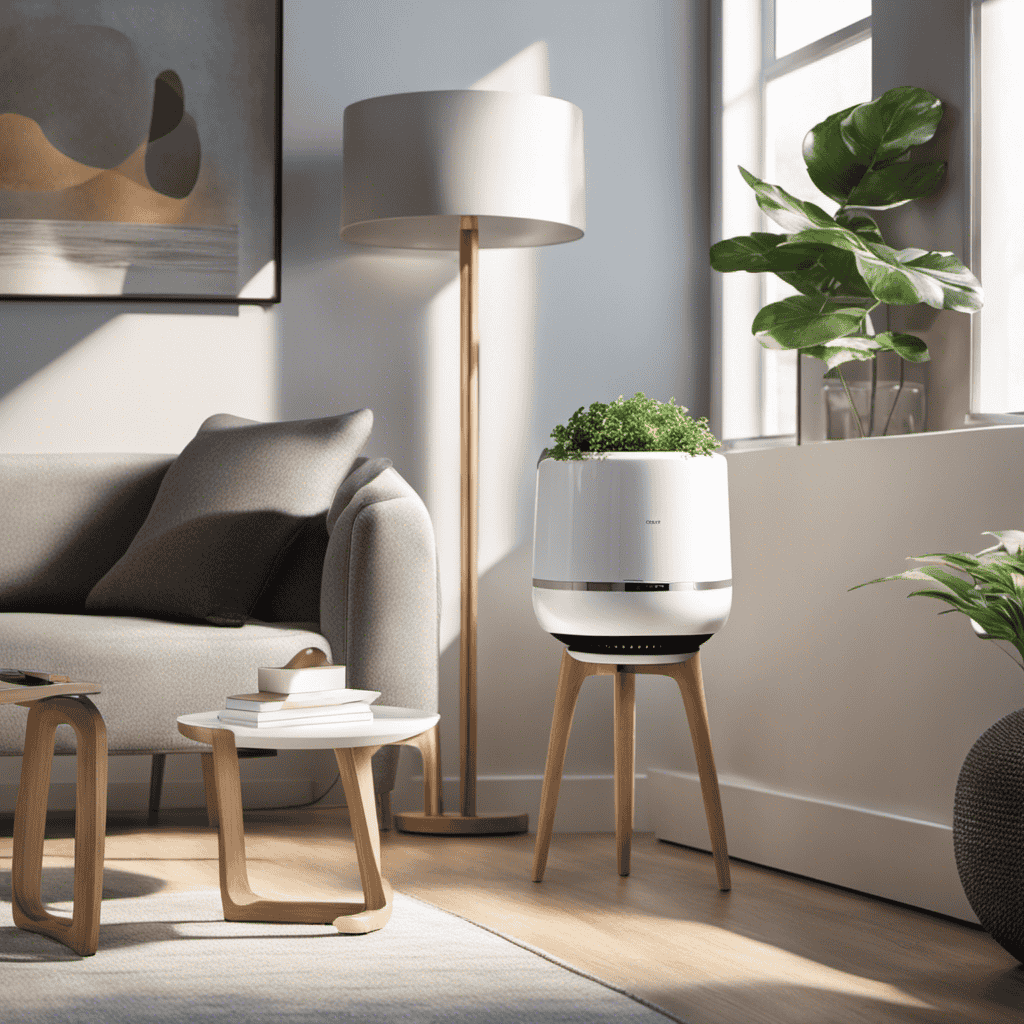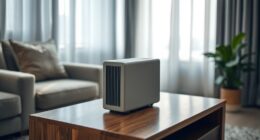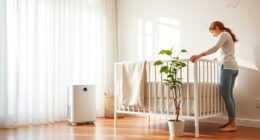Have you ever been curious about the role of an ionizer in an air purifier? Allow me to illuminate this fascinating technology for you.
In this article, we will explore how an ionizer works, the benefits it provides, and its impact on indoor air quality. Additionally, we will address common misconceptions and safety concerns surrounding ionizers.
So, join me as we delve into the world of ionizers and discover their role in creating cleaner and healthier air for you and your loved ones.
Key Takeaways
- Ionizers release negatively charged ions that attach to positively charged particles in the air, causing them to become heavier and fall to the ground or stick to surfaces.
- The use of ionizers in air purifiers reduces allergens, neutralizes odors, kills bacteria and viruses, and improves respiratory health.
- Ionizers emit negatively charged ions into the air, which attach to airborne particles like dust and pollen, enhancing the efficiency of pollutant removal and improving overall air quality.
- Ionizers in air purifiers use electricity to produce negative ions, which attach to airborne particles, making it easier for the air purifier to capture and remove them, without producing harmful ozone.
How an Ionizer Works in an Air Purifier
An ionizer in an air purifier releases negatively charged ions to neutralize airborne pollutants. These ions attach themselves to positively charged particles in the air, such as dust, pollen, and smoke, causing them to become heavier and fall to the ground or stick to surfaces.
The role of negative ions in air purification is to effectively remove these pollutants from the air, improving the overall air quality. The effectiveness of ionization in air purifiers has been studied extensively, with research showing that negative ions can effectively reduce the concentration of airborne particles, including allergens and bacteria.
Additionally, negative ions have been found to have a positive impact on mood and overall well-being. Understanding the role and effectiveness of negative ions in air purifiers is essential in realizing the benefits of using an ionizer for cleaner and healthier air.
Benefits of Using an Ionizer in an Air Purifier
Using an ionizer in your air purifier can offer several benefits. Ionizers work by emitting negatively charged ions into the air, which attach to particles such as dust, pollen, and pet dander, causing them to become heavy and fall to the ground. This helps to reduce allergens and improve the overall air quality in your home. Additionally, ionizers can also help to neutralize odors and kill bacteria and viruses in the air. Studies have shown that ionizers can be effective in reducing airborne contaminants, improving respiratory health, and providing relief for allergy sufferers. It is important to note that the effectiveness and longevity of ionizers in air purifiers can vary depending on factors such as room size, filtration system, and maintenance. Regular cleaning and maintenance are necessary to ensure optimal performance.
| Benefit | Effectiveness | Longevity |
|---|---|---|
| Reduces Allergens | ✓ | ✓ |
| Neutralizes Odors | ✓ | ✓ |
| Kills Bacteria and Viruses | ✓ | ✓ |
| Improves Respiratory Health | ✓ | ✓ |
Understanding the Role of Ionizers in Air Purifiers
As an expert in air purification technology, I’ve extensively researched the role of ionizers in improving indoor air quality.
Ionizers, commonly found in air purifiers, work by emitting negatively charged ions into the air. These ions attach themselves to airborne particles, like dust, pollen, and pet dander. Consequently, the particles become heavy and either fall to the ground or get trapped by the purifier’s filters.
Using ionizers in air purifiers offers several benefits. Firstly, it enhances the efficiency of pollutant removal. Secondly, it reduces allergens in the air. Lastly, it improves the overall air quality.
Ionizers and Air Purification
You can understand how ionizers work in air purifiers by learning about their role in improving air quality.
Ionizers are devices that use electricity to produce negative ions, which attach to airborne particles and cause them to become heavier. This makes it easier for the air purifier to capture and remove these particles from the air.
It is important to note the differences between ionizers and ozone generators. While both devices produce ions, ozone generators also produce ozone, which can be harmful to human health. Ionizers, on the other hand, do not produce ozone and are considered safe for use in portable air purifiers.
Benefits of Ionizers
One of the benefits of ionizers in air purification systems is that they improve indoor air quality. Ionizers work by releasing negatively charged ions into the air, which attach to positively charged particles such as dust, pollen, and smoke, causing them to become heavy and fall to the ground. This process effectively removes these particles from the air, reducing their concentration and improving overall air quality.
Additionally, ionizers can be particularly beneficial for individuals with allergies or respiratory issues. By removing allergens and irritants from the air, ionizers can help alleviate symptoms such as sneezing, coughing, and wheezing. The reduction of airborne particles can also help prevent respiratory infections and improve overall respiratory health.
However, it is important to note that ionizers should be used in conjunction with other air purification methods, such as filters, to ensure comprehensive air cleaning.
Differences Between Ionizers and Other Air Purification Technologies
When it comes to air purification, understanding the differences between ionizers and other technologies is essential.
In comparing ionizers to HEPA filters, it’s important to note that while both can effectively remove particles from the air, HEPA filters are generally more efficient in trapping smaller particles.
Similarly, when comparing ionizers to activated carbon, it’s important to consider that while both can remove odors and chemicals, activated carbon is typically more effective in absorbing volatile organic compounds (VOCs).
Lastly, in comparing ionizers to UV-C lamps, it’s important to recognize that while both can kill germs and bacteria, UV-C lamps have a more targeted approach and are specifically designed for this purpose.
Ionizers Vs. HEPA Filters
The ionizer in an air purifier can be more effective at removing smaller particles compared to HEPA filters. This is especially beneficial for individuals with allergies, as smaller particles such as pollen, dust mites, and pet dander are often the main triggers.
In fact, studies have shown that ionizers can effectively reduce the levels of these allergens in the air, providing relief for allergy sufferers.
In commercial air purifiers, ionizers are commonly used alongside other filtration technologies to maximize the removal of harmful particles. The ionizer works by emitting negative ions into the air, which attach to the positively charged particles, causing them to become heavy and fall to the ground or be trapped in the purifier’s filter.
This dual action of ionization and filtration makes ionizers a powerful tool in improving indoor air quality and reducing allergy symptoms.
Ionizers Vs. Activated Carbon
To maximize the removal of odors and chemical pollutants, you should consider using activated carbon filters in your air purification system. These filters are designed to absorb and trap volatile organic compounds (VOCs) and other harmful gases.
When comparing ionizers to activated carbon filters, there are some key differences to consider:
-
Ionizers vs. ozone generators: Ionizers release negatively charged ions into the air to neutralize pollutants, while ozone generators produce ozone gas to eliminate odors. However, ozone can be harmful to human health and should be used with caution.
-
Ionizers vs. electrostatic precipitators: Ionizers use electrostatic charges to attract and remove airborne particles, while electrostatic precipitators use an electric field to capture particles on charged plates. Both technologies are effective in removing particles, but electrostatic precipitators require regular cleaning to maintain efficiency.
Ionizers Vs. UV-C Lamps
In my previous discussion on ionizers, I compared their effectiveness with activated carbon filters. Now, let’s delve into how ionizers stack up against UV-C lamps in air purifiers.
Ionizers and UV-C lamps both aim to improve indoor air quality, but they work in different ways. Ionizers release negative ions into the air, which attach to airborne particles and make them heavy enough to fall out of the air. On the other hand, UV-C lamps emit ultraviolet light that damages the DNA of microorganisms, such as bacteria and viruses, rendering them unable to reproduce.
When comparing ionizers to ozone generators, it’s important to note that some ionizers can produce small amounts of ozone as a byproduct. Ozone generators, however, intentionally produce ozone, which can be harmful to human health.
Additionally, ionizers can be compared to electrostatic precipitators. Both technologies charge particles, but ionizers release ions to attract particles, while electrostatic precipitators use charged plates to trap particles.
Overall, the choice between ionizers and UV-C lamps, ozone generators, or electrostatic precipitators depends on individual needs and preferences.
Common Misconceptions About Ionizers in Air Purifiers
Contrary to popular belief, ionizers in air purifiers do not produce harmful ozone. This is a common misconception that has led to concerns about the potential dangers of using air purifiers with ionizers. However, extensive research and testing have debunked these myths and shown that ionizers are safe and effective in improving indoor air quality.
Here are some key points to consider:
-
Ionizers work by emitting negatively charged ions into the air, which attach to positively charged particles like dust, pollen, and pet dander. This process causes the particles to become heavy and fall to the ground or stick to surfaces, effectively removing them from the air.
-
Some air purifiers with ionizers also include a collection plate or filter to capture the particles, ensuring they are not re-released into the air.
Overall, ionizers are a valuable addition to air purifiers, providing an extra layer of filtration and improving the overall effectiveness of the device. It is important to understand the facts and dispel the misconceptions surrounding ionizers to make informed decisions about air purification.
The Science Behind Ionization in Air Purifiers
Understanding how ionization works in air purifiers can help you appreciate the role it plays in improving indoor air quality. Ionization is the process by which air purifiers release negatively charged ions into the air. These ions attach themselves to positively charged particles such as dust, pollen, and pet dander, causing them to become heavier and fall to the ground or stick to surfaces. This effectively removes these particles from the air, reducing their concentration and improving air quality.
While ionization is an effective method for air purification, it is important to be aware of potential dangers associated with it. Research studies have shown that high levels of ionization can produce ozone, a harmful gas that can irritate the respiratory system and exacerbate existing health conditions. Therefore, it is crucial to choose air purifiers with low ozone emission levels and to properly maintain them to ensure their safe and effective operation.
Ionizers Vs. Filters: Which Is More Effective in Air Purification
When it comes to air purification, the effectiveness of ionizers versus filters is a topic of great debate.
Ionizers work by releasing charged ions into the air, which attach to particles and cause them to fall to the ground.
On the other hand, filters physically trap particles in a mesh or media, preventing them from circulating in the air.
Both methods have their pros and cons, and understanding their effectiveness is crucial in choosing the right air purifier for your needs.
Effectiveness of Ionizers
To determine if ionizers are effective in purifying the air, you can look for scientific studies and customer reviews. Here are some key points to consider:
-
Scientific Studies:
-
Many studies have shown that ionizers effectively remove airborne pollutants such as dust, smoke, and pollen.
-
Some studies have found that ionizers can also reduce the concentration of bacteria and viruses in the air.
-
Customer Reviews:
-
Many customers have reported noticeable improvements in air quality after using ionizers.
-
Some customers have mentioned that ionizers have helped alleviate allergy symptoms and respiratory issues.
It’s important to note that while ionizers can be effective in purifying the air, some models may produce ozone as a byproduct. Ozone is a known lung irritant and can be harmful to human health in high concentrations. Therefore, it’s crucial to choose an ionizer that has been certified as ozone-free or produces ozone within safe levels.
Filtering Vs. Ionization
If you’re deciding between filtering and ionization, it’s important to consider their different methods of improving indoor air quality.
Ionizers and ozone generators are two different technologies used for air purification. While ionizers work by releasing negative ions into the air to attach to airborne particles, ozone generators produce ozone gas that reacts with pollutants.
Ionizers are generally considered safer as they do not produce harmful ozone levels, unlike ozone generators.
On the other hand, when comparing ionizers with electrostatic precipitators, both technologies use charged particles to attract and capture pollutants. However, electrostatic precipitators use an electric field to charge particles, while ionizers rely on the ionization process.
It is crucial to understand these differences when choosing the right method for improving the air quality in your indoor environment.
Potential Health Risks Associated With Ionizers in Air Purifiers
There are potential health risks associated with ionizers in air purifiers. While these devices are designed to improve indoor air quality, it is important to consider the safety concerns that come with their use.
Here are some potential health risks to be aware of:
-
Ozone production: Ionizers generate ozone as a byproduct, which can be harmful when inhaled in high concentrations. Ozone can irritate the respiratory system, leading to coughing, wheezing, and shortness of breath.
-
Negative ions: While negative ions have been associated with various health benefits, such as improved mood and increased energy levels, excessive exposure to these ions may cause respiratory issues for individuals with asthma or allergies.
It is crucial to carefully evaluate the ionizer’s ozone emission levels and consider the potential health risks before using air purifiers with ionizers. Regular maintenance, proper ventilation, and following manufacturer guidelines can help mitigate these risks and ensure a safe indoor environment.
How to Choose the Right Air Purifier With an Ionizer
When it comes to choosing an air purifier, understanding the differences between an ionizer and a HEPA filter is crucial.
An ionizer works by releasing negative ions into the air, which attach to pollutants and make them heavier, causing them to fall out of the air.
On the other hand, a HEPA filter uses a mesh of fibers to trap particles such as dust, pollen, and pet dander.
While both options have their advantages, the benefits of ionizers include their ability to remove odors and kill certain types of bacteria and viruses, making them a popular choice for eliminating airborne contaminants.
Ionizer Vs. HEPA Filter
You should consider the benefits of an ionizer over a HEPA filter in an air purifier.
- An ionizer uses charged particles to remove pollutants from the air, while a HEPA filter traps particles physically.
- Ionizers can be more effective in removing smaller particles such as smoke, dust, and pet dander.
- Unlike HEPA filters, ionizers do not need to be replaced regularly, saving you money in the long run.
When comparing ionizers to electrostatic precipitators, it’s important to note that both work on the principle of charging particles. However, ionizers are generally more compact and portable, making them a convenient choice for smaller spaces.
In contrast, ionizers are different from ozone generators, which intentionally emit ozone into the air. While ionizers can produce trace amounts of ozone as a byproduct, ozone generators purposefully emit high levels of ozone, which can be harmful to human health.
Considering these factors, it is clear that ionizers have several advantages over HEPA filters in terms of efficiency, cost-effectiveness, and convenience.
Benefits of Ionizers
To fully understand the advantages of ionizers, it’s important to consider their effectiveness in removing smaller particles like smoke, dust, and pet dander. Ionizers work by emitting negatively charged ions into the air, which attach themselves to airborne particles and cause them to become heavy and fall to the ground or adhere to surfaces. This process helps to improve indoor air quality by reducing the number of allergens and irritants in the air.
In addition to their effectiveness, ionizers also have other benefits. They are often more energy-efficient than other types of air purifiers, consuming less electricity to operate. However, it’s worth noting that ionizers do have potential health risks. The release of ozone as a byproduct of ionization can be harmful to individuals with respiratory conditions. Therefore, it’s important to choose an ionizer that meets safety guidelines and limit exposure to ozone.
Maintenance and Cleaning Tips for Ionizers in Air Purifiers
Regularly cleaning the ionizer in your air purifier is essential for maintaining its effectiveness. Dust and other particles can accumulate on the ionizer plates over time, reducing its ability to effectively clean the air. Here are some maintenance tips and cleaning techniques to keep your ionizer in top condition:
-
Maintenance Tips:
-
Remove and clean the ionizer plates according to the manufacturer’s instructions.
-
Check the plates for any signs of damage or wear and replace if necessary.
-
Cleaning Techniques:
-
Use a soft brush or cloth to gently remove dust and debris from the plates.
-
Soak the plates in a mixture of warm water and mild detergent to remove stubborn dirt.
-
Rinse the plates thoroughly and allow them to dry completely before reinserting into the air purifier.
Best Practices for Using an Air Purifier With an Ionizer
When using an air purifier with an ionizer, it’s important to follow these best practices to ensure optimal performance.
First, consider the placement of your air purifier. It should be placed in a central location within the room, away from walls and furniture, to allow for proper air circulation. This will enhance the effectiveness of the ionizer in removing pollutants from the air.
Additionally, make sure to clean or replace the filters regularly to maintain the overall efficiency of the air purifier.
Lastly, be mindful of the ionizer’s effectiveness and consider using it in conjunction with other air purifying technologies, such as activated carbon filters, to maximize the purification process.
The Impact of Ionizers on Indoor Air Quality
Using ionizers in air purifiers can have both benefits and drawbacks.
On one hand, ionizers are effective in removing specific pollutants from indoor air. They work by releasing negatively charged ions into the air, which attach to positively charged particles like dust, pollen, and pet dander. This causes the particles to become heavy and fall out of the air, improving air quality.
However, there are potential drawbacks to using ionizers. One concern is the production of ozone, a harmful gas that can worsen respiratory conditions. Another drawback is that ionizers may not be as effective in removing larger particles or volatile organic compounds (VOCs). Therefore, it is important to consider these factors when choosing an air purifier with an ionizer.
Transitioning into the next section, it is crucial to explore whether ionizers are safe for pets and children.
Are Ionizers Safe for Pets and Children
You should be aware of the potential safety concerns for your pets and children when using ionizers in your home. While ionizers are often used to improve indoor air quality and reduce allergens, there are some considerations to keep in mind.
Research suggests that ionizers may release ozone, which can be harmful to both humans and animals. Ozone can irritate the respiratory system and worsen symptoms of allergies and asthma. It is important to monitor the ozone levels produced by ionizers and ensure they are within safe limits.
Additionally, some ionizers may produce negative ions, which can attract dust and other particles, potentially leading to respiratory issues if not properly maintained. It is advisable to consult with a professional and follow manufacturer guidelines to ensure the safe use of ionizers around pets and children.
Energy Efficiency of Air Purifiers With Ionizers
In my previous subtopic, I discussed the safety of ionizers in air purifiers for pets and children. Now, let’s delve into the energy efficiency of air purifiers with ionizers.
It is important to consider the energy consumption and environmental impact of these devices.
Here are some key points to consider:
-
Energy consumption:
-
Air purifiers with ionizers may consume more energy compared to those without ionizers due to the additional components and processes involved in ionization.
-
Look for air purifiers with Energy Star certification, as they are designed to be more energy-efficient.
-
Environmental impact:
-
Ionizers produce ozone as a byproduct, which can contribute to air pollution and have adverse effects on human health and the environment.
-
Opt for air purifiers with low ozone emission levels or those that have ozone-free ionization technology.
Comparing Ionizers in Different Air Purifier Brands
When comparing different brands of air purifiers, I take note of how the ionizers in each brand differ in terms of energy efficiency and environmental impact. Ionizers are an important feature in air purifiers as they help to remove airborne pollutants and allergens, which can aggravate allergies and asthma symptoms.
Research has shown that ionizers can effectively neutralize harmful particles in the air by charging them with negative ions. These charged particles then attach to positively charged surfaces, such as walls or furniture, allowing them to be removed from the air.
However, it is essential to consider the energy efficiency and environmental impact of ionizers. Some brands may consume more energy to generate ions, resulting in higher electricity bills. Additionally, certain ionizers may release ozone, which can be harmful to the environment and human health.
Therefore, it is crucial to choose air purifiers with ionizers that are energy-efficient and have minimal environmental impact, ensuring clean and healthy air for those with allergies and asthma.
Frequently Asked Questions
Can Ionizers in Air Purifiers Be Harmful to Pets and Children?
Ionizers in air purifiers can potentially have harmful effects on pets and children. Safety precautions, such as keeping them out of reach and using low ozone-emitting models, should be followed to minimize any risks.
How Energy Efficient Are Air Purifiers With Ionizers?
Air purifiers with ionizers are energy efficient because they use less power than traditional models. They work by releasing negatively charged ions that attach to airborne particles, making them heavier and easier to filter out.
Is There a Difference in the Effectiveness of Ionizers in Air Purifiers Across Different Brands?
There is a difference in the effectiveness of ionizers in air purifiers across different brands. When comparing ionizer performance, it is important to consider factors such as technology, design, and customer reviews.
How Do Ionizers Compare to Other Air Purification Technologies in Terms of Energy Consumption?
When comparing ionizers to other air purification technologies in terms of energy consumption, it is important to consider the pros and cons of ionizers and their effectiveness in comparison to HEPA filters.
Are There Any Potential Health Risks Associated With Using Ionizers in Air Purifiers?
There may be potential health risks associated with using ionizers in air purifiers. It is important to compare their effectiveness with other air purification technologies and consider any potential negative effects on human health.
Are Ionizers in Air Purifiers Effective in Improving Air Quality?
Ionizer on air purifier explained: Ionizers in air purifiers are effective in improving air quality by releasing negative ions that attach to and neutralize harmful pollutants such as dust, pollen, and smoke. This process removes these particles from the air, leading to cleaner and healthier indoor air for breathing.
Conclusion
In conclusion, after researching ionizers in air purifiers, I’ve learned about their significant role in improving indoor air quality. These devices use charged ions to capture and remove harmful particles from the air, making it cleaner and safer to breathe.
One interesting metaphor to describe the impact of ionizers is comparing them to a diligent and meticulous housekeeper. They tirelessly work to eliminate dust and allergens from your home.
With their efficiency and effectiveness, air purifiers with ionizers are an excellent investment for a healthier living environment.
